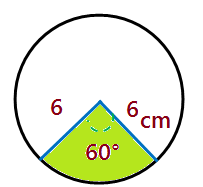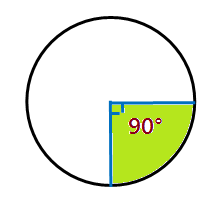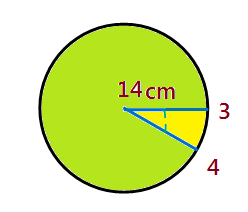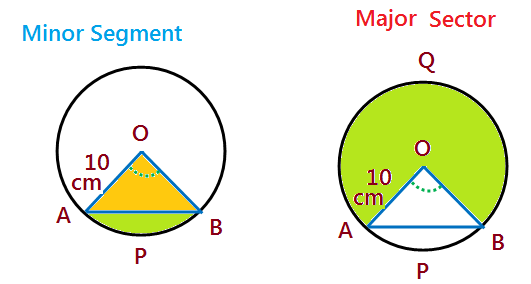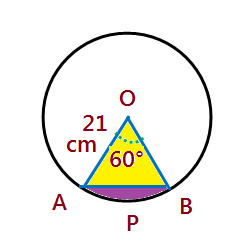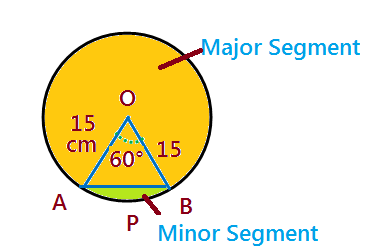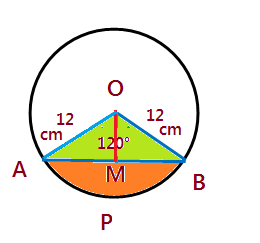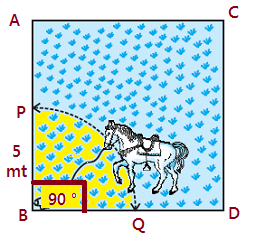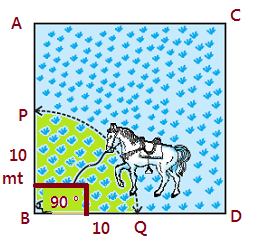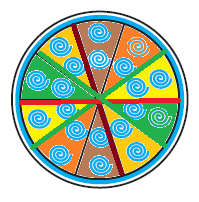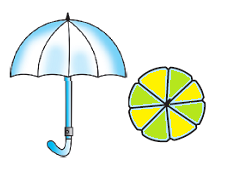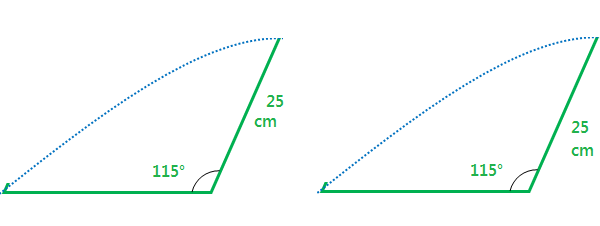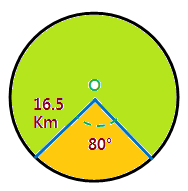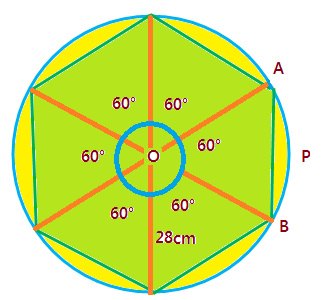Unless stated otherwise, take π = 22/7.
Find the area of a sector of a circle with radius 6 cm if angle of the sector is 60°.
Solution :
Given that : Radius of circle = 6 cm
Angle of a sector of a circle, θ = 60°.
We know that,
Area of a sector of a circle = $$ {\theta \over {360°} }× \pi {r^2}$$
Area of a sector of a circle = $$⇒ {60° \over {360°} }× { 22 \over 7 }×{(6)^2} $$
$$⇒ {1 \over 6} × { 22 \over 7 }×{36} $$
$$⇒ { 22 \over 7 }×{6} $$
$$⇒ { 132 \over 7 } cm^2 $$
$$ 18.85 cm.^2$$
Thus, area of the given sector of circle = 18.85 $cm^2 $
Find the area of a quadrant of a circle whose circumference is 22 cm.
Solution :
Given that :
Circumference of a circle, 2 $\pi $r = 22 cm.
$$ 22 = 2 \pi r $$
$$⇒ {22 \over {2} }× { 7 \over 22 }= r $$
$$⇒ {7 \over {2} }= r $$
We know that,
Area of a sector of a circle = $$ {\theta \over {360°} }× \pi {r^2}$$
It is given that we need to find the area of a quadrant thus θ = 90°.
( Quadrant of a circle means one of the four equal parts. )
Area of quadrant can be calculated as follows:
$$⇒ {90° \over {360°} }× { 22 \over 7 }×{({ 7 \over 2 })^2} $$
$$⇒ {1 \over 4} × { 22 \over 7 }×{ 49 \over 4 } $$
$$⇒ { 77 \over 8 } cm^2$$
$$ 9.625 cm.^2 $$
Thus, Area of the given quadrant of a circle = 9.625 $cm^2 $
The length of the minute hand of a clock is 14 cm. Find the area swept by the minute hand in 5 minutes.
Solution :
Given that :
Length of the minute hand of a clock, or radius of circle= 14 cm.
The minute hand makes an angle of 360° in 60 minutes.
Angle rotated by the minute hand in 5 minutes =
$$⇒ 360° × {5 \over {60°} }= 30° $$
We know that,
Area of a sector of a circle = $$ {\theta \over {360°} }× \pi {r^2}$$
( Area swept by minute hand = Area of a sector of a circle )
The area of the sector of central angle 30°:
$$⇒ {30° \over {360°} }× { 22 \over 7 }×{(14)^2} $$
( It is given that radius, r = 14 cm. and θ = 30°)
$$⇒ {1 \over {12} }× { 22 \over 7 }× 14 × 14 $$
$$⇒ {1 \over {12} }× { 22 }×{14 }× 2 $$
$$⇒ {1 \over {3} }× { 22 }× 7 $$
$$⇒ { 154 \over 3 } cm^2$$
$$ 51.33 cm.^2 $$
Thus, The required area swept by the minute hand by 5 minute = 51.33 $cm^2 $
A chord of a circle of radius 10 cm subtends a right angle at the centre. Find the area of the corresponding:
(i) minor segment, (ii) major sector. (Use $\pi $ = 3.14)
Solution :
Given that :
Radius of the circle, r = 10 cm.
Angle at the centre of circle, θ = 90°.
Let AB be the chord of the circle subtending 90° angle at centre O of the circle.
1) Area of minor segment APB = Area of minor sector(APBO) – area of triangle (ABO)
We know that,
Area of a sector of a circle = $$ {\theta \over {360°} }× \pi {r^2}$$
Area of minor sector(APBO):
$$⇒ {90° \over {360°} }× { 3.14 }×{(10)^2} $$
$$⇒ {1 \over {4} }× { 3.14 }×{100 }$$
$$⇒ {1 \over {4} }× 314 $$
$$⇒ 78.5 cm^2 $$
Now , We know that,
Area of triangle = $$ {1 \over 2 }× Base × Height $$
Area of triangle (ABO) formed by two radii:
$$⇒ {1 \over 2 }× 10 × 10 $$
$$⇒ {1 \over 2 }× 100 $$
$$⇒ 50 cm^2 $$
Calculation of area of Minor Segment
Area of minor segment APB = Area of minor sector(APBO) – area of triangle (ABO)
Area of minor segment = $$ 78.5 - 50 $$
Area of minor segment = $ 28.5 cm^2 $
2) Area of major sector OAQB =
( Major segment is making Angle = 360° - 90° = 270° )
$$⇒ {270° \over {360°} }× { 3.14 }×{(10)^2} $$
$$⇒ {3 \over {4} }× { 3.14 }×{100 }$$
$$⇒ {3 \over {4} }× { 314 }$$
$$⇒ 235.5 cm^2 $$
Area of major segment = $235.5 cm^2 $
In a circle of radius 21 cm, an arc subtends an angle of 60° at the Centre. Find:
(i) the length of the arc,
(ii)area of the sector formed by the arc,
(iii)area of the segment formed by the corresponding chord.
Solution :
Given that :
Radius of the circle, r = 21 cm.
Angle at the centre of circle, θ = 60°.
Let AB be the chord of the circle subtending 60° angle at centre O of the circle.
1) Length of Arc APB can be calculated as follows:
We know that,
Length of Arc = $$ {\theta \over {360°} }× {2 \pi r}$$
Length of Arc(APB):
$$⇒ {60° \over {360°} }× 2 × {22 \over 7 } × 21 $$
$$⇒ {1 \over {6} }× 2 × 22 × 3 $$
$$⇒ {1 \over {2} }× 2 × 22 $$
$$⇒ 22 cm $$
Hence, length of arc = 22 cm.
2) Area of corresponding sector can be calculated as follows:
We know that,
Area of a sector of a circle OAPB = $$ {\theta \over {360°} }× \pi {r^2}$$
$$⇒ {60° \over {360°} }× {22 \over 7 }×{(21)^2} $$
$$⇒ {1 \over {6} }× {22 × 21 × 3} $$
$$⇒ {1 \over {2} }× {22 × 21 } $$
$$⇒ {11 × 21 } $$
$$⇒ 231 cm^2 $$
Hence, area of sector = $231 cm^2 $
(3) Area of the segment formed by the corresponding chord can be calculated as follows:
Area of the segment APB = (Area of a sector of a circle OAPB) – (area of triangle (ABO))
Now , We know that,
As the angle made by radius is 60°, so this is an equilateral triangle; because angles opposite to both radius will be equal.
Area of equilateral triangle can be calculated as follows:
Area of an equilateral triangle = $$ {\sqrt 3 \over 4 }× side^2 $$
$$⇒ {\sqrt 3 \over 4 }× 21 × 21 $$
$$⇒ 441{\sqrt 3 \over 4 } cm^2$$
= 190.953 cm2
Calculation of area of Minor Segment
Area of the segment APB = (Area of a sector OAPB) – (area of triangle (ABO))
⇒ 231 cm2 - 190.95 cm2
⇒ 40.05 cm2
Thus, Length of Arc = 22 $ cm $
Thus, Area of the sector formed by the arc= 231 $ cm^2 $
Thus, Area of minor segment = 40.05 $ cm^2 $
A chord of a circle of radius 15 cm subtends an angle of 60° at the centre. Find the areas of the corresponding minor and major segments of the circle.
(Use $\pi $ = 3.14 and $ \sqrt 3 $ = 1.73 ).
Solution :
Given that :
Radius of the circle, r = 15 cm.
Angle at the centre of circle, θ = 60°.
Let AB be the chord of the circle subtending 60° angle at centre O of the circle.
1) Area of minor segment APB = Area of minor sector(APBO) – area of triangle (ABO)
Now, Area of minor sector can be calculated as follows:
We know that,
Area of a sector of a circle(APBO) = $$ {\theta \over {360°} }× \pi {r^2}$$
$$⇒ {60° \over {360°} }× 3.14 ×{(15)^2} $$
$$⇒ {1 \over {6} }× 3.14 × {15 × 15} $$
$$⇒ {1 \over {2} }× 3.14 × {15 × 5} $$
$$⇒ {117.75 }cm^2 $$
Now , We know that,
As the angle made by radius is 60°, so this is an equilateral triangle; because angles opposite to both radius will be equal.
Area of equilateral triangle can be calculated as follows:
Area of an equilateral triangle = $$ {\sqrt 3 \over 4 }× side^2 $$
$$⇒ {\sqrt 3 \over 4 }× 15 × 15 $$
$$⇒ 225{\sqrt 3 \over 4 } cm^2$$
= 97.312 cm2
Calculation of area of Minor Segment
Area of minor segment APB = Area of minor sector(APBO) – area of triangle (ABO)
$$⇒ 117.75 cm^2 - 97.312 cm^2 $$
$$⇒ 20.43 cm^2 $$
Thus, Area of minor segment = $ 20.43 cm^2 $
2) Area of major segment AQB
= Area of circle – Area of minor segment APB
$$⇒ { 3.14 }×{(15)^2}- 20.43 $$
( Area of circle = $\pi {r^2}$)
$$⇒ { 3.14 }×{225 } - 20.43 $$
$$⇒ 706.50 - 20.43 $$
$$⇒ 686.07 cm^2 $$
Thus, Area of minor segment = 20.43 $ cm^2 $
Thus, Area of major segment = 686.07 $ cm^2 $
A chord of a circle of radius 12 cm subtends an angle of 120° at the centre. Find the area of the corresponding segment of the circle.
(Use $\pi $ = 3.14 and $ \sqrt 3 $ = 1.73 ).
Solution :
Given that :
Radius of the circle, r = 12 cm.
Angle at the centre of circle, θ = 120°.
Let AB be the chord of the circle subtending 120° angle at centre O of the circle.
1) Area of minor segment APB = Area of minor sector(APBO) – area of triangle (ABO)
Now, Area of minor sector can be calculated as follows:
We know that,
Area of a minor sector (APBO) = $$ {\theta \over {360°} }× \pi {r^2}$$
$$⇒ {120° \over {360°} }× 3.14 ×{(12)^2} $$
$$⇒ {1 \over {3} }× 3.14 × {12 × 12} $$
$$⇒ 3.14 × 12 × 4 $$
$$⇒ {150.72 }cm^2 $$
Now, consider the triangle:
In Δ AOB
Let us draw a perpendicular OM from the center of the circle on chord AB of the triangle.
OM ⊥ AB , It will bisect the chord AB,
AM = BM = ${1 \over 2}$ AB
M is the mid-point of ∠AOB and base, AB
Therefore, $\angle $ AOM = ${1 \over 2}$ $\angle $ AOB = 60°
Now, in Δ OAM
$\angle $ OMA = 90°
Δ OAM is right angle triangle
$$ cos 60° = {OM \over {OA} }$$
$$⇒ {1 \over 2} = {OM \over 12 }$$
$$⇒ OM = 6 cm.$$
Also ,
$$ sin 60° = {AM \over {OA} }$$
$$⇒ {\sqrt 3 \over 2} = {AM \over 12 }$$
$$⇒ AM = 6 \sqrt 3 $$
Here AB = 2 AM
⇒ AB = 2 × $ 6 \sqrt 3 $ = 12 $ \sqrt 3 $
Now , We know that,
Area of triangle = $$ {1 \over 2 }× Base × Height $$
Area of triangle (ABO) :
$$⇒ {1 \over 2 }× {12 \sqrt 3 } × 6 $$
$$⇒ {36 \sqrt 3 }$$
$$⇒ {36 × 1.73 }$$
$$⇒ 62.28 cm^2 $$
Calculation of area of Minor Segment
Area of minor segment APB = Area of minor sector(APBO) – area of triangle (ABO)
$$⇒ 150.72 cm^2 - 62.28 cm^2 $$
$$⇒ 88.44 cm^2 $$
Thus, Area of minor segment = 88.44 $ cm^2 $
A horse is tied to a peg at one corner of a square shaped grass field of side 15 m by mans of a 5 m long rope (see figure). Find
(i) The area of that part of the field in which the horse can graze
(ii) the increase in the grazing area if the rope were 10 m long instead of 5 m.
(Use $\pi $ = 3.14 ).
Solution :
Answer :
From the figure, it can be observed that the horse can graze a sector of 90° in a circle of 5 m radius.
Radius of the circle, r = 5 mt.
Angle at the centre of circle, θ = 90°.
The area of the part of the field in which the horse can graze = Area of the Quadrant of a circle
We know that,
Area of a sector (BPQ) = $$ {\theta \over {360°} }× \pi {r^2}$$
$$⇒ {90° \over {360°} }× 3.14 ×{(5)^2} $$
$$⇒ {1 \over {4} }× 3.14 × {5 × 5} $$
$$⇒ {78.5 \over {4} } $$
$$⇒ {19.625 }m^2 $$
(ii) the increase in the grazing area if the rope were 10 m long
Now r =10 mt.
Area of a sector (BPQ) = $$ {\theta \over {360°} }× \pi {r^2}$$
$$⇒ {90° \over {360°} }× 3.14 ×{(10)^2} $$
$$⇒ {1 \over {4} }× 3.14 × {10 ×10} $$
$$⇒ {314 \over {4} } $$
$$⇒ { 78.5 }m^2 $$
Increase in grazing area = = 78.5 – 19.625
= 58.875 m2
Thus, Increase in grazing area = 58.875 $ m^2 $
A brooch is made with silver wire in the form of a circle with diameter 35 mm. The wire is also used in making 5 diameters which divide the circle into 10 equal sectors as shows in the Figure. Find
(i) the total length of the silver wire required,
(ii) the area of each sector of the brooch.
Solution :
Given, Diameter, d = 35 mm.
Radius of the circle, r = 35/2 = 17.5 mm.
(i) the total length of the silver wire required.
Total length of wire required will be the length of 5 diameters and the circumference of the brooch.
The circumference of the brooch:-
$$⇒ {2 \pi r}$$
$$⇒ {2 ×{22 \over 7} × 17.5}$$
$$⇒ {110}mm $$
Now, length of 5 diameter = diameter × 5
$$ ⇒ 35 × 5 = 175 mm $$
Total Length of the silver wire required = = circumference + total length of 5 diameter
$$ ⇒ 110 + 175 $$
$$ = 285 mm $$
(ii) The area of each sector of the brooch
The total number of lines present in the brooch is 10 (line starting from the centre).
Since the 5 diameters divide the circle into 10 equal sectors, the area of each sector is the total area divided by 10.
We know that, Area of circle = $\pi {r^2}$
The Area of each sector of the Brooch
$$⇒ {1 \over 10} ×{22 \over 7} ×{({35 \over 2})^2} $$
$$⇒ {1 \over 10} ×{22 \over 7} ×{35 \over 2}×{35 \over 2} $$
$$⇒ {{11 × 35 }\over 4} $$
$$⇒ {385 \over 4}mm^2 $$
$$⇒ 96.25 mm^2 $$
Thus, Area of each sector of brooch = 96.25 $ mm^2 $ ,and
Total length of wire required = 285 mm
An umbrella has 8 ribs which are equally spaced (see figure). Assuming umbrella to be a flat circle of radius 45 cm, find the area between the two consecutive ribs of the umbrella.
Solution :
Given,Radius of the umbrella , r = 45 cm.
(i) The Area of a sector between two consecutive ribs
To find the area between two consecutive ribs, you can think of the umbrella as a flat circle divided into 8 equal sectors by the ribs.
Therefore, the area between any two consecutive ribs is the area of a single sector.
We know that, Area of circle = $\pi {r^2}$
The Area of a sector between two consecutive ribs
Since there are 8 equally spaced ribs, the total area is divided into 8 equal sectors.
So area of each sector 1/8 the area of circle.
$$⇒ {1 \over 8} ×{22 \over 7} ×{(45)^2} $$
$$⇒ {1 \over 8} ×{22 \over 7} ×{45}×{45} $$
$$⇒ {{11 × 45 × 45}\over 28} $$
$$⇒ {22275 \over 28}cm^2 $$
$$ 795.54 cm^2. $$
Thus, The Area of a sector between two consecutive ribs = 795.54 $ cm^2 $
A car has two wipers which do not overlap. Each wiper has a blade of length 25 cm sweeping through an angle of 115°. Find the total area cleaned at each sweep of the blades.
Solution :
The area swept by one wiper is the area of a sector with a radius equal to the length of the blade and a central angle equal to the sweeping angle.
Given,Radius of the wiper , r = 25 cm.
Sweeping angle = Angle at the circle, θ = 115°
We know that, Area of sector = $ {\theta \over {360°} }× \pi {r^2}$
Total Area cleaned by the two wipers :
2 × Area Cleaned by one wiper
( Since the car has two wipers that do not overlap, the total area cleaned is simply twice the area of a single wiper's sweep. )
$$⇒ 2 × {\theta \over {360°} }× \pi {r^2} $$
$$⇒ 2 × {115° \over {360°} } × {22 \over 7} ×{(25)^2} $$
$$⇒ 2 × {23 \over {72} } × {22 \over 7} ×{25 }×{25 } $$
$$⇒ {23 \over {18} } × {11\over 7} ×{25 }×{25 } $$
$$⇒ {158125 \over 126}cm^2 $$
$$⇒ {1254.9 }cm^2 $$
Thus, Total Area cleaned at each swipe of the blade $⇒ {1254.9 }cm^2 $
To warn ships for underwater rocks, a lighthouse spreads a red coloured light over a sector of angle 80° to a distance of 16.5 km. Find the area of the sea over which the ships are warned.
(Use $\pi $ = 3.14 ).
Solution :
To find the area over which the ships are warned, we need to calculate the area of the sector formed by the lighthouse's light.
Given, Distance of spread of light, i.e , r = 16.5 Km.
Angle at the circle, θ = 80°
We know that, Area of sector = $ {\theta \over {360°} }× \pi {r^2}$
Total Area of the sea over which the ships are warned :
$$⇒ {\theta \over {360°} }× \pi {r^2} $$
$$⇒ {80° \over {360°} } × {3.14} ×{(16.5)^2} $$
$$⇒ {2 \over {9} } × {3.14} ×{16.5 }×{16.5 } $$
$$⇒ {2 \over {9} } × {3.14} ×{165 \over 10 }×{ 165 \over 10 } $$
$$⇒ {3.14} ×{11 }×{ 11 \over 2 } $$
$$⇒ {379.94 \over 2}Km^2 $$
$$⇒ {189.97 }Km^2 $$
The area of the sea over which ships are warned is 189.97 $ km^2$
A round table cover has six equal designs as shown in Figure. If the radius of the cover is 28 cm, find the cost of making the designs at the rate of Rs. 0.35 per $cm^2 $ .
(Use $\sqrt 3 $ = 1.7 )
Solution :
The six designs divide the table cover into six equal sectors. Each design is a segment, which is the area of a sector minus the area of the triangle within that sector.
The given combined shape is combination of a circle and a regular hexagon.
Let us join ends of the designs
We know that sum of angles at point O = 360°
Since there are six equal designs, the angle of each sector is = 360° / 6 = 60°
Now , In ΔOAB,
ΔOAB is isosceles As two sides are equal ,
( OA = OB = Radius of the circle )
Therefore ,$ \angle OAB = \angle OBA $
( because angles opposite to both radius will be equal )
Sum of angles of triangle = 180°
$$⇒ \angle OAB + \angle OBA + \angle AOB = 180° $$
$$⇒ 2 \angle OAB + 60° = 180° $$
$$⇒ 2 \angle OAB = 180° - 60° = 120° $$
$$⇒ \angle OAB = 60° $$
Therefore, ΔOAB is an equilateral triangle
The area of the hexagon will be equal to six equilateral triangles with each side equal to the radius.
Given, r = 28 cm.
Now, we know that area of an equilateral triangle = $ {\sqrt 3 \over 4 }× (side)^2 $
$$ {\sqrt 3 \over 4 }× (28)^2 $$
$$⇒ {\sqrt 3 \over 4 }× 28 × 28 $$
$$⇒ 196 × {\sqrt 3} $$
$$⇒ 196 × 1.7 $$
$$⇒ 333.2 cm^2 $$
Now, we know that, Area of sector of angle, θ =
$$⇒ {\theta \over {360°} }× \pi {r^2} $$
Angle at the circle, θ = 60°
$$⇒ {60° \over {360°} } × {22 \over 7 } ×{(28)^2} $$
$$⇒ {1 \over {6} } × {22 \over 7 } ×{28 }×{28 } $$
$$⇒ {1 \over {3} } × 11 × 4 ×{28 } $$
$$⇒ {1232 \over {3} } $$
$$⇒ {410.66 }cm^2 $$
Area of segment APB = Area of sector − Area of triangle
$$⇒ {410.66 } - 333.2 $$
$$⇒ 77.46 cm^2 $$
There are six equal designs, so the total area is
Area of design = 6 × Area of one segment APB
$$⇒ 6 × 77.46 $$
$$⇒ 464.76 cm^2 $$
Total Cost = Total Area × Rate
Thus, cost of making of design = 464.76 x 0.35 = Rs. 162.66
Total Cost is ₹. 162.66
Tick the correct answer in the following:
Area of a sector of angle p (in degrees) of a circle with radius R is
(A) $ {p \over {180} }× 2\pi R $
(B) $ {p \over {180} }× \pi R^2 $
(C) $ {p \over {360} }× 2\pi R $
(D) $ {p \over {720} }× 2\pi R^2 $
Solution :
Area of a sector of angle p° of a circle with radius R
angle = p°
Radius = R
We know that, Area of sector of angle, θ =
$$ {\theta \over {360°} }× \pi {r^2} $$
Substituting values we get :
Multiplying numerator and denominator by 2, we get :
$$ {p \over {2(360°)} }× 2\pi {R^2} $$
$$ {p \over {720°} }× 2\pi {R^2} $$
∴ Correct answer is option D
Syllabus for class 10
Advanced courses and exam preparation.
Previous Year Paper
Advanced courses and exam preparation.
Mock Test
Explore programming, data science, and AI.
